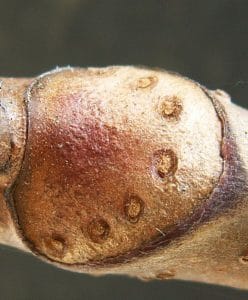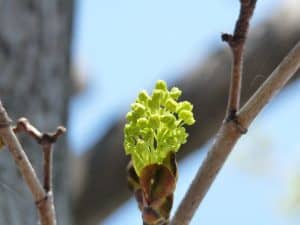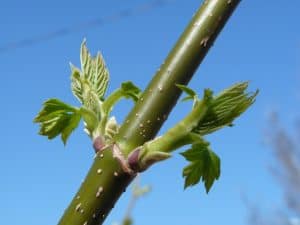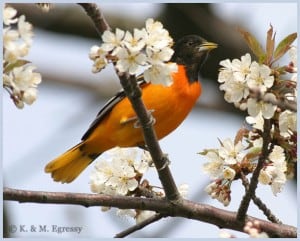Exploring the characteristics of twigs and buds is a great winter pastime
After the dramatic reds, oranges and yellows of fall leaves, it’s easy to think that the seemingly barren trees of winter offer little of interest. Fortunately, for those of us who enjoy winter botanizing, the trees are anything but barren. A closer look reveals that they are adorned with buds, tiny jewels that harbour the promise of spring. Better still, they provide a surefire way to identify the tree. All that’s needed are observant eyes – a curious nose can help, too – and some knowledge of what species grow in our area.
Although we tend not to notice them until autumn when the leaves have fallen, the buds of most species have been present since summer. Stored within three kinds of buds, the tree’s entire future lies in waiting. Leaf buds contain embryonic stems and leaves – miniaturized, folded and pressed together like the tiniest and tightest of parachutes. They are biding their time, waiting for their turn to capture sunlight and manufacture food. Flower buds, as their name suggests, contain one or more flowers. We often forget that trees are flowering plants in the same way as roses and tulips. As such, they produce flowers whose goal it is to produce seeds and assure a new generation. Flower buds are generally larger than leaf buds, sometimes differently shaped (e.g., red and silver maples) and often located at the tip of the twig (terminal bud). Finally, trees also have mixed buds, which house all three structures – undeveloped stems, leaves and flowers. It’s usually necessary to dissect a given bud to know exactly what is hidden inside.
Bud biology
Although trees can usually be identified by their overall shape and by characteristics of the bark, buds provide a much more reliable means of identification. The starting point for understanding buds is to be able to recognize the twig, the part of the branch where the buds are located. The twig is the section at the end of each branch that constitutes the previous year’s growth. A twig’s point of origin is marked by a distinctive, ring-like node around the branch and a change in the colour and smoothness of the bark. The node is where the scales of the previous year’s terminal bud fell off and left several lines encircling the twig. For this reason, it is called a bud scale scar. To see how much the twig grew last year, measure the distance from the tip of the twig to the first bud scale scar. You can usually find the bud scale scars from two and three years ago, as well.
Bud arrangement is critical information in species identification. Because buds form in the angle between the stem and the stalk of the leaf, both leaves and buds have the same arrangement on the twig. In opposite arrangement, the buds on the sides of the twig (lateral buds) are located directly across from each other. In alternate arrangement, they are staggered singly at intervals along the twig. Only a few genera of trees and shrubs have opposite buds and leaves. This makes their identification easy. They include honeysuckle, ash, maple, lilac, viburnum, elderberry and dogwood. Just about all of the other tree and shrub species are alternate. The following mnemonic (memory aid) that I devised – which unintentionally sounds like a rallying call for animals rights – may be helpful in remembering these seven groups: HAM LIVED! Each genera or group corresponds to one letter in the mnemonic; lilac corresponds to LI. Start by learning the opposite buds, especially maple, ash and dogwood, and then move on to some of the common and distinctive alternate species like poplar, elm and willow.
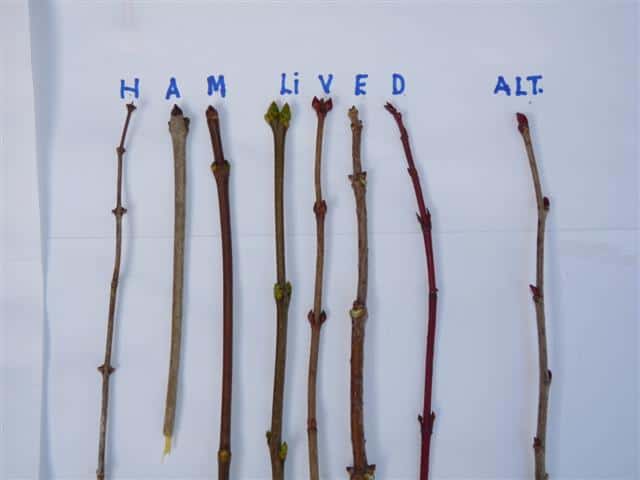
Opposite buds (H=honeysuckle, A=ash, M=maple, LI=lilac, V=viburnum, E=elderberry, D=Dogwood) Alternate Basswood buds on far right.
If you take a closer look at a bud, you will notice that it is covered with scales. These structures, which are usually leathery and sometimes hairy, serve to protect the embryonic leaves and flowers from the elements. The number, shape and arrangement of the bud scales are different for each species of tree. Beneath the scales, you will sometimes find tiny hairs, which provide additional protection to the bud’s precious cargo. Pussy willow buds are a well-known example of this feature.
Below each bud, you will also see a leaf scar. It marks the location where last summer’s leaf was attached. The scar therefore corresponds in shape to the base of the leaf stem. Each tree species has its own characteristic leaf scar, almost like the tree’s fingerprint. In red maples, the scar is U-shaped, while in white ash there is usually a deep notch in the scar. You may need a small hand lens to see this. If you look carefully at a leaf scar, you will see tiny markings known as bundle scars where veins passed from the stem of the leaf into the twig. These veins carried water into the leaf and food – made through photosynthesis – back out into the twig and to the rest of the tree. In some species – black walnut, for example – the leaf scar looks like a little face.
A primer
Let’s look at the buds and twigs of some familiar, easy-to-find species. You might want to go outside and gather these or use Google Images as a visual reference.
1. Sugar maple: Shiny, reddish-brown twigs with opposite buds. Buds are brown and conical, almost looking like upside down ice-cream cones, minus the ice cream. Covered by 6-8 pairs of scales, which are arranged in staggered rows. Large terminal bud. V-shaped leaf scar, containing 3 bundle scars.
2. Red oak: Reddish brown twigs with alternate buds. Buds are reddish-brown with 10 or more bud scales. Terminal buds form a cluster. Leaf scar is a semi-circle with numerous, scattered bundle scars.
3. American basswood: Light-brown, smooth twigs of zigzag shape. Buds are reddish, plump and opposite. 2-3 bud scales of unequal size. Leaf scar is semi-circular with 3 bundle scars.
4. Balsam poplar: My favourite winter buds! Narrow, long, pointed alternate buds with 4 leaf scales. Terminal bud larger, up to 25 mm, with 5 scales. Leaf scar roughly circular with 3 bundle scars. All buds are resinous and exude the smell of spring when rolled between your fingers.
Numerous guides for winter tree identification can be found online. Just Google “winter tree identification Ontario”. I especially like “Appendix C Winter Tree ID”, which should come up first in the search results.
Activities
1. What’s inside? Try opening some buds to see what’s hidden below the scales. Lilac and horse-chestnut buds work especially well. Using tweezers or just your fingers, try peeling back the scales and unfolding the contents. Count the tiny leaves inside. A hand lens will come in handy. Can you already see what shape the leaves are? Children are often amazed to see so many miniscule leaves are hidden inside such a small object. Large lilac and horse-chestnut buds may have tiny, pre-formed flowers inside. For small children, try cutting open some Brussels’ sprouts, which are actually large, immature leaf buds containing tightly overlapping leaves.
2. A twig collection: Collect the twigs of the most common trees and shrubs of your area. Attach these to a piece of cardboard with a glue gun, grouping them by opposite and alternate. Make sure you include twigs with both side and terminal buds. Cutting the twigs at an angle will expose the pith (the inside of the twig), which can also help in identification. Label each species.
3. Sneak preview: If you just can’t wait for spring to arrive, try forcing twigs for indoor blooming and leafing out. I’ve had especially good luck with dogwood, forsythia, crabapple, silver maple and birch twigs, but any species is worth trying. Head outside and cut off foot-long twigs with big, healthy buds. Make an angled cut at the base. Strip away buds and twigs that will be under water. Smash the woody bases with a hammer to enhance water absorption. Place in a water-filled vase in a cool, dark spot. Once the buds start to open – usually 7-12 days – move to a window, but out of direct sunlight. The cooler the spot, the longer the leaves and blooms will last. You might want to photograph or sketch the leaves, stems and flowers as they emerge. Try to identify which buds produced leaves and which produced flowers – or both!
Spring’s promise
Knowing these finer details of our trees and shrubs opens up a whole new world of winter beauty and adds immeasurably to any outing. Keep in mind that by March, sap will flow upwards from the tree’s roots, directing water and minerals to the buds and causing them to swell. With the warm days of late April and May, a new generation of leaves, shoots and flowers will emerge. The new growth will provide food for legions of insects, which in turn will become fuel for the rest of the food chain. The song of a Baltimore oriole on a May morning is directly linked to the buds of the winter forest.
